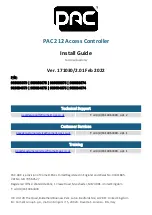
Toothed Wheel
ACNT
ACNT
Toothed Wheel
Tick CNT
Tick CNT
0
n
n
Acceleration
Deceleration
Step Width
Angle Functions
1000
SPNU563A – March 2018
Copyright © 2018, Texas Instruments Incorporated
High-End Timer (N2HET) Module
23.3.2.2.1.3 Acceleration and Deceleration
Because the toothed wheel speed is inconstant, it creates discontinuities in the angle counter behavior.
If the TCKC reaches zero before a new active tooth edge during a deceleration, the angle tick signal is no
longer generated by the SCNT and PCNT(n-1). This halts the ACNT until the new active tooth arrives.
If the TCKC is unequal to zero when the new active tooth edge arrives during an acceleration (that is, the
falling edge on the toothed wheel input in the example below), the rest of the tick counter increments the
ACNT. For an example of the ACNT during acceleration and deceleration, see
.
Figure 23-41. ACNT During Acceleration and Deceleration
23.3.2.2.1.4 End of Cycle
The HWAG behaves differently during the singularity tooth period of the toothed wheel. During the
singularity period, the HWAG counts three virtual teeth (that is, three times the step width is added to the
ACNT) to ensure that the ACNT reaches the maximum value (that is, every angle step has been counted)
before resetting it.
During the singularity period, the HWAG generates angle ticks like for a normal tooth but with three times
the value. To generate these angle ticks, the HWAG uses a constant period based on the previous tooth
period. Because the period is based on the previous tooth period, the HWAG must recover from a
deceleration or acceleration of three teeth when realizing the active edge tooth at the end of the singularity
tooth.
The HWAG must ensure that the singularity occurs where expected and must verify it. When the
singularity tooth arrives, TCNT reaches the teeth register, sets the signal gap flag, and then keeps
PCNT(n-1) until the first tooth of the next round has passed. Because of these conditions, angle ticks
before the second tooth will be based on the previous singularity tooth period.
The tick counter is first loaded with a normal value. When the counter reaches zero, it is reloaded once
with twice the step width value if the criteria flag is not set. PCNT(n) continues to be incremented and to
check the criteria with PCNT(n-1). For more information on gap verification, see
. The
SCNT continues to generate angle ticks until the tick counter reaches zero the second time. The criteria
flag validates the tooth in order to reset the counters. For an example of how the criteria flag validates the
tooth to reset the counters, see
.
When the tooth active edge occurs, the ACNT is incremented with the remainder value if the tick counter
is not equal to zero. When the ACNT contains a value equals to K times the teeth register, the PCNT, the
TCNT and the ACNT are reset to begin a new revolution.
















































